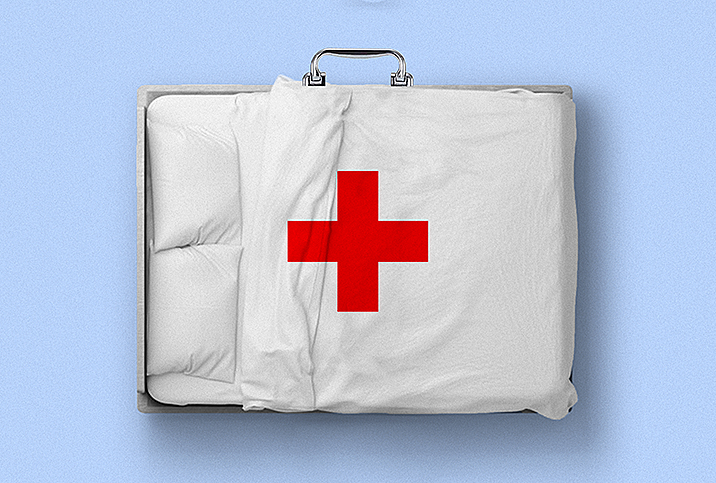Safer Sex Between Two Women

Traditional sex education is generally built on, well, tradition, and that means it generally serves primarily heterosexual couples: one man, one woman. This can leave people on the LGBTQIA+ spectrum in the dark when it comes to sexual health because most sex ed disempowers women. And queer people with vulvas are even further marginalized and left with dangerous misconceptions about sexual safety.
A 2018 study published in the Journal of Adolescent Health found that bisexual and lesbian girls ages 14 to 18 were less likely to use protective barriers during sex because of a lack of knowledge of sexual risk.
There are no coincidences or surprises in the study's findings: There are only nine states in America where sex ed must be inclusive of sexual orientation. According to the Centers for Disease Control and Prevention (CDC), much of the research around sexual health in LGBTQIA+ youth centers predominantly on gay and bisexual boys.
'Knowing how to use a condom doesn't matter if what folks actually need to know is how to use a dental dam.'
Sex educators Heather Welty and Al Albertson from Queer Sex Ed Community Curriculum, a community-centered platform that provides free queer-inclusive and socially conscious sex ed, explain inclusive sex ed must center on the experiences and needs of their audiences or else its efforts are futile.
"The heteronormative sex education offered today may be effectively useless to the kind of sex and experiences queer folks are having. Knowing how to use a condom doesn't matter if what folks actually need to know is how to use a dental dam," Welty and Albertson offered in a statement.
The gray area of sex ed
Sex can mean a multitude of different things for anyone, but especially people with vulvas: from oral sex to anal play; clitoral play with penetration; penetration with fingers, toys, or tongues; sex using sex toys or scissoring, to name a few possibilities.
Which sex acts people wish to engage in are completely dependant on their personal preferences. Because of these infinite possibilities, sex ed for same-sex female couples is often a gray area and can leave people more confused about what safety guidelines to follow.
"The first step to addressing safer sex practices for people with vulvas is abandoning the myth that sex equals penetration," Welty and Albertson added. "This means that sex for people with vulvas can be truly expansive and exploratory, and in turn, the options for safer sex practices are respectively vast. The specific methods you use should come down to the context and realities of you and your sexual partner's various needs."
Sexual safety practices rely entirely on which practices you and your partner may choose and, of course, communication is imperative.
Safe sex starts before the bedroom
Because sex between people with vulvas can mean myriad things, the first step is deciding on a safety protocol before setting foot in the bedroom. And that means a discussion should take place and things need to be decided.
Antithetical to how mainstream movies show two strangers meeting and then instantly falling into bed with one another, sexual health starts with talking—using your words—about what you will or won't do and what you do or don't agree to. Communication is harm reduction, as Welty and Albertson point out.
They recommend a sexual inventory stocklist and encourage people to communicate boundaries regarding fluid sharing and specific sex acts.
Central to safe sex are sexually transmitted infections (STI) screenings. JV, a sex educator from Masakhane Center, adds that open communication (which can be anything from talking about an STI status or telling a partner to slow down) is a crucial ingredient to a more satisfying sexual experience.
"Communication can include the following. Disclosing your STI status (including if you're currently waiting for results from testing), and talking about safer sex practices [you've] used with other partners. And being honest with ourselves and others if we're concerned and are looking to get tested or are currently experiencing symptoms we may want to talk to a healthcare provider about," JV explained. "This is all part of informed consent."
The facts: You can still get STIs
Casey, a student, went to an OB-GYN a few years ago after receiving an abnormal Pap test result due to HPV. She wanted to know safer sex options she could implement with a new partner so as to not spread the virus. Her doctor told her she wouldn't spread HPV from "the things she and a partner could do."
That is patently false.
"STIs can be transmitted through genital-to-genital contact, touching genitals of an infected partner and then touching your own genitals or sharing unsanitized sex toys," said sexual health expert Sherry Ross, M.D., OB-GYN. "HPV and herpes can also be passed through oral, vaginal and anal contact."
To be clear, when exchanging bodily fluids, sexual contact between people with vulvas can spread all the usual suspects, including HPV, herpes and chlamydia.
Ross recommends getting tested between partners. But will a negative STI panel mean you're good to go? She said it's reassuring but explained that a regular STI panel may be unable to rule out the presence of HPV.
Safety with sex toys
It's not uncommon for same-sex female partners to involve some additional accessories. Ross recommends keeping an eye on such tools.
"Chlamydia, gonorrhea, syphilis and HPV can be found on sex toys, so it's important to clean your sex toys well," she said. "Porous sex toys are especially more prone to trapping STIs. [It's best to] avoid toys that are absorbent, spongy, permeable or have porous/semi-porous materials, since they increase the risk of bacteria buildup, which can cause yeast, bacterial or urinary tract infections."
And the best way to wash your toys? Ross said "overkill" might be the best plan of attack.
"Clean your sex toys before and after using them with warm water and antibacterial soap," she said. "Antibacterial sex toy cleaners are available in many sex toy stores. Boiling or placing them in the dishwasher—top rack is best—can also sterilize them. To help prevent the growth of bacteria, be sure to dry each sex toy thoroughly after cleaning."
Nail maintenance (it's that important)
Keeping your nails properly groomed is specifically central to sex acts involving a vulva: Fingering is common, so you want to make sure you do it as safely as possible.
"Dirty and sharp fingernails not only cause tears on the vulva and inside the vagina, but can also lead to vaginal infections including yeast and bacteria," Ross explained.
Micro-tears in the vagina can increase susceptibility to STIs. If you're going for an acrylic manicure or have long nails, make sure to go for a rounded tip rather than a pointed one.
In an article about keeping long nails while having sex with partners with vulvas, self-appointed queer sexpert Corinne Werder said painful fingering is more about jagged nails, rough cuticles and hangnails than the length of manicure. However, longer nails could trap more dirt, so thoroughly washing your hands before sex is always a good idea.
What depth of fingering feels acceptable is different for everyone. If you're wondering how your manicure might feel on a partner, try it on your own vulva first. And when you're with a partner, go slow and check in from time to time.
What to know about barriers
When you've decided how you and a partner might have sex, you can pair barriers with specific sex acts. Barriers like dental dams work to prevent STI transmission. No dental dam? Welty and Albertson noted you can cut up a condom to achieve the same effect. If you're sharing dildos or other toys between partners, you can always use condoms on toys, too.
If you're pairing lube with latex dental dams or gloves, remember to use water-based lube because oil-based lubes degrade latex and can make those barriers less safe and more susceptible to tears.
If you're skipping a barrier but still want to ensure safety, JV suggests a safer sex practice such as mutual masturbation or avoiding fluid exchange altogether by touching each other over underwear.
Fluid bonding, the conscious decision not to use barriers and exchange fluids with only your partner, is another option. Fluid bonding should not be a choice that you make as you're about to have sex, though. Disclosure about STI status and STI testing, as well as agreed boundaries, need to be discussed before you're that involved.
No matter how you and your partner choose to have sex, there are ways to lower the risk of transmitting STIs and other diseases. Open communication about your boundaries and preferences is a great place to start.


















